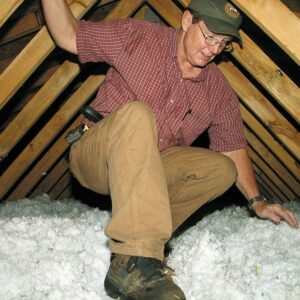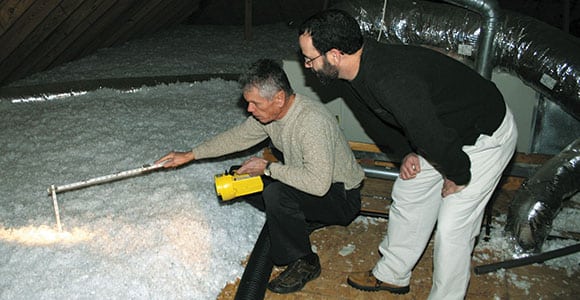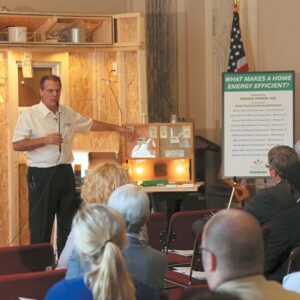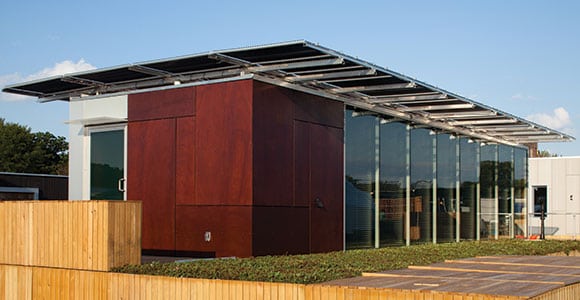If there is more than one person living in your home, chances are at some point you haven’t agreed on where the house thermostat should be set. In the winter, do you run the heat at a temperature that is comfortable and pay more on your electric bill, or do you wear more layers of clothing to allow for running the heating at a lower temperature to save some extra dollars? Hot summer months present the same dilemmas: when to turn on the air conditioning and how high you are willing to set the temperature in order to avoid high cooling costs. These questions may be even more important than you know since your HVAC unit adds more to your energy costs each year than anything else in your home.
 Even so, it’s not the only thing to consider. Every small change you can make toward having an energy-efficient home is going to leave more dollars in your pockets. That’s everything from energy-efficient appliances to sealing up air leaks and utilizing easy and free changes in behavior.
Even so, it’s not the only thing to consider. Every small change you can make toward having an energy-efficient home is going to leave more dollars in your pockets. That’s everything from energy-efficient appliances to sealing up air leaks and utilizing easy and free changes in behavior.
Fortunately, energy-saving products combined with efficient home design trends and building techniques are revolutionizing home energy use.
Regardless of location or type of residence, people are finding that being energy-efficient at home not only brings comfort but also positively impacts both wallets and the world.
“If you’re concerned about the environment, being energy-efficient is a priority,” says Brian Sloboda, senior program manager with the National Rural Electric Cooperative Association (NRECA). “But efficient energy use is important for other reasons. First, you save money. Second, you save energy, which leads back to saving money.”
It’s easy for us to ignore being wise with our energy consumption. After all, electricity is a good value, especially when compared to other forms of energy. Unlike other sources of energy, however, electricity is very flexible — we can use electricity for everything from helping with cooking and cleaning to powering entertainment devices and even our automobiles. Regardless, it makes sense (and cents) to be more energy-efficient in all areas, especially at home.
“Energy efficiency is a pocketbook issue,” explains Alan Shedd, director of residential and commercial energy programs for NRECA’s Touchstone Energy Home program. “If you can do things to reduce the cost of energy, you will have more money to spend on other things. Sure, we can’t control all energy costs — gasoline, for example — but we can make a difference in our own home.”
But how do we make that difference? How can you still be comfortable and avoid sending your spouse or significant other into a frenzy when he or she opens the monthly electric bill? Experts say future home construction and remodeling will focus on energy efficiency. Properly sealing a home is one of the key things to focus on in new construction or remodeling.
Pat Garrett, residential energy advisor for Duck River Electric Membership Corporation, agrees: “Properly sealing a home is very important, and the easiest time to caulk around all penetrations is before drywall is installed. It will help with about 5 percent to 20 percent of electric costs and with HVAC and moisture issues.”

Doing detective work
Home energy audits help consumers identify points of energy loss. Often performed by electric co-op employees or other trained professionals, energy audits use special tools to pinpoint potential improvements.
“Using a meter to connect to the breaker box, we make sure that no energy users are running when they are not supposed to be,” says Meriwether Lewis Electric Cooperative Energy Specialist Gene Hale. “We look at everything from the crawl space to the attic. Attic insulation is the most common opportunity we find for improvement that provides good returns on investment.”
MLEC, like many other Tennessee electric cooperatives, provides incentive programs for making homes more energy-efficient. MLEC’s Home Insulation Program offers residential customers a rebate for half the cost (up to $500) of bringing their attic insulation up to the industry standard of R-38.
“We know that adequate insulation can help members save year-round,” Hale says. “Our insulation program began as a pilot in November 2011. To date, more than 300 homes have participated in the program. We estimate the average savings for each to be about $150 annually.”
Many co-ops such as Southwest Tennessee Electric Membership Corporation join with the Tennessee Valley Authority’s In-Home Energy Evaluation (IHEE) program to help members lower power use and thus monthly energy costs. Not only that, the program offers cash incentives or financial assistance for improvements to your home’s energy efficiency.
“The program has been working very well for us,” says Marilyn Maxwell, marketing and energy services coordinator for STEMC.
For full details on the program, visit TVA’s page dedicated to the IHEE: www.tva.gov/ee/in_home_eval.htm.
Digging down for deeper savings
Perhaps nothing is as valuable to consumers as savings realized after installing a geothermal heat pump as an alternative to more traditional means of heating and cooling. Using a series of liquid-filled loops buried at least 10 feet underground, this system uses the steady temperature below ground to transfer heat.
Installation costs are high, but geothermal heat pumps deliver a 30-percent to 70-percent reduction in home heating and cooling costs. Plus, by using a desuperheater, geothermal heat pumps deliver around 60 percent of a family’s water-heating needs for free. This waste heat recovery system works best in the summer but also provides “free” hot water in the other months.
Because of their connection to the Earth, geothermal heat pumps represent an interesting application of renewable energy and receive tax credits.
Jim Dulley, writer of the “Sensible Home” and “Cut Your Utility Bills” nationally syndicated columns, says geothermal heat pumps pay for themselves in just a few years.
“Geothermal is the most efficient system for heating and cooling,” he says. “It’s hard to beat.”
Designed to save
Jimmy Autry, senior vice president of membership and community relations for Flint Energies of Reynolds, Ga., points out that older homes were built to a different standard, when energy was less expensive and efficiency was less important. Energy efficiency is a key concern for new home construction, he adds.
“We are willing to get involved with new home construction,” Autry says. “It is a one-time decision about insulation, caulking and weather stripping. With a little up-front investment, you build in less overall operating costs.”

Eastern Illini Electric Cooperative in Paxton, Ill., designed a demonstration tool for consumer energy-efficiency education. The 18-foot-long Energy Efficiency Wall is a popular exhibit at home shows, fairs and special events, showcasing more than a dozen ways energy can leak through a home’s walls.
“People see everything we’ve been saying, and it makes sense,” explains Bob Dickey, Eastern Illini’s manager of marketing and economic development. “Showing people what to do is different than telling them. This has been a very valuable tool for us.”
How to justify that new refrigerator
Energy efficiency comes not only from construction methods but also from a home’s appliances. Like the houses themselves, many appliances and products are designed and manufactured with an emphasis on saving energy. Clothes washers, refrigerators and other household aids bearing the Energy Star logo are specifically designed for a higher level of efficiency.
Energy Star is branded by the U.S. Department of Energy and Environmental Protection Agency, a designation placed on products that have been tested and shown to provide significant energy savings over comparable products that do the same thing.
When electricity first appeared in rural areas in the 1930s and 1940s, many electric cooperatives had appliance showrooms or offered demonstrations. Today, co-ops tend to partner with TVA to offer rebates and low-interest financing for energy-efficiency improvements.
One tip that is easy and bears no cost is to simply turn off and unplug appliances when they are not in use. How often have you left the TV on when no one was in the room watching it? Or instead of using your dishwasher’s drying cycle, allow your dishes to air-dry. If you walk through your home, making a list of all the ways you can shave off a little electric use here and there, you might be surprised by the cumulative savings on your next bill.
The future is now
Much of the emphasis on energy efficiency is not new, but it has become more important over the years. Because energy prices were a lot lower back when people started getting electricity in their homes, little was done regarding efficiency. Today, our homes consume a lot more energy. We’ve come a long way from the single lightbulb in the ceiling, so it’s increasingly important to be conscious of how much energy our various appliances consume and try to cut that consumption.

Thanks to more stringent building codes, new homes are much more energy-efficient than just a few years ago. And co-op representatives see even more moves toward energy efficiency in the future.
“New technology with heat pumps and thermostats will continue to improve,” says Kevin Roy, energy advisor at Pickwick Electric Cooperative. “Controlling appliances and a home’s climate with smart phones will become more common. And eventually, home construction will improve.”
Kerry D. Watson, vice president of customer care at Gibson Electric Membership Corporation, believes the co-op will continue to see an emphasis on energy-efficiency programs and services it offers to members.
“Some of these already include PAY-Go (prepaid electricity) so customers can see how much energy they use on a daily basis as well as our USave Programmable Thermostat Program where members can control their thermostats with their smart phones and mobile devices.”



